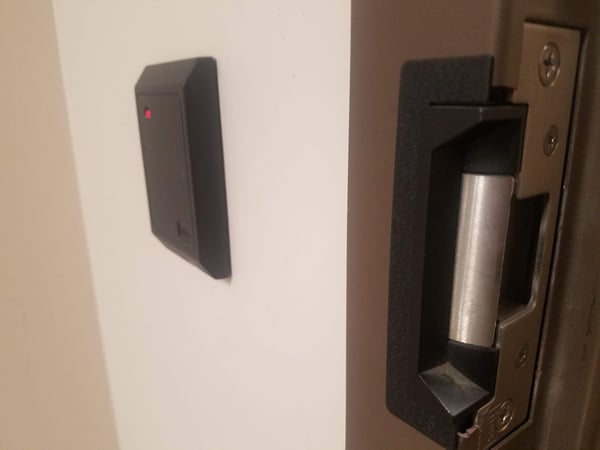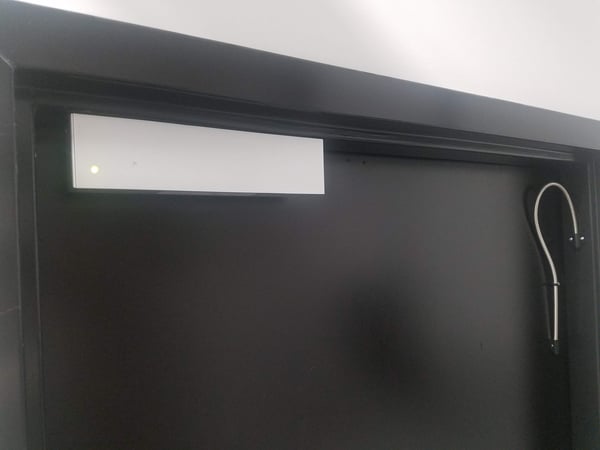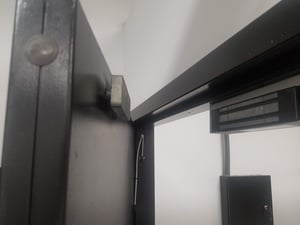
Access control locks on doors have come a long way in the past 30 years or so. They contribute more than you might think to our safety and security while at work, or while spending time in public buildings such as schools, government buildings, and healthcare facilities.
There’s a lot more than meets the eye when it comes to electronic door locking hardware. Because of their importance to safety and security, we thought we’d spend some time exploring two of the most common types of access control locks in use on buildings today — electric strike locks and magnetic locks — and discuss their different features, benefits, and potential drawbacks.
If you own or manage any kind of commercial building, healthcare facility or school, this post will give you a better understanding of these two very popular locks, including some of the advantages and disadvantages of each.
First, let’s define some of the “lingo” associated with door locks
You’ll often see the terms “fail-safe” and “fail-secure” when looking at different access control systems. These are important terms to understand because they tell you how the lock will function in the event of a power failure:
- “Fail-Safe” requires power to lock the door. If power is lost, then the door will become unlocked. (Typically Mag Locks)
- “Fail-Secure” requires power to unlock the door. If power is lost, then the door will remain locked. (Typically Door Strikes)
It’s also important to have a basic understanding of the different parts and how they function together. Most door locks have three major components that work together to keep the door secure. They include the handle and the latch (the small metal bolt that sticks out of the side of the door when open), which together make up the lockset, and the strike. The strike, or “strike plate” is the metal plate or assembly installed on the inside of the door frame and is aligned to receive the latch and hold it secure.
Electronic locks are the norm for exterior doors on public buildings today, while both mechanical and electronic locks may be used on interior doors. This post focuses on magnetic locks (“mag locks” and electric strike locks (”electric strikes”), which are two different types of electronic locks and use electrical hardware devices to maintain the security of a door opening.

Electric Strike Locks or “Electric Strikes”
Electric strikes are electromechanical door locking devices, meaning they are mechanical locks with electronic devices that provide additional functionality.
Electric strikes are used in combination with another form of locking devices, such as a lock set or a panic bar. They are installed in place of the conventional lock strike plate on the inside of the door frame. Electrical power is supplied to the strike, which holds the latch or lock bolt in place, keeping the door locked until the release system is activated.
The type of release system chosen will vary based on the application. Examples of release systems for electric strikes include reception release buttons, a keypad for entering passcodes, electronic key card or fob readers, etc. Once the release system is activated, a hinged piece of metal inside the electric strike will pivot to allow the door to open without having to turn the door handle.
The lock or panic hardware functions independently of the electric strike. Therefore, while the electric strike plate functions to keep the door locked from the outside, even if the power is out, you can still open the door from the inside by turning the door handle or pushing the touchpad of the panic hardware. This is an example of a fail-safe function. However, depending on the application, most electric strikes can be set to either fail-safe or fail-secure using an integral switch.

Magnetic or “Mag” Locks
Mag locks are electromagnetic door locking devices. A mag lock consists of a large electromagnet installed along the top of a door frame and a metal plate on the door that lines up with it. The lock functions by passing an electric current through the electromagnet, creating a magnetic charge that attracts the plate and holds it in place against the door frame. This keeps the door securely locked until the power is removed or interrupted.
Examples of release systems for mag locks include many of the same devices as for electric strikes. When energized, a mag lock can create a retention force greater than 1,000 pounds, making it a very effective lock. That is, until the power is cut. Because mag locks by design require a constant supply of electricity to remain locked, mag locks are fail-safe only — they do not function to keep the door locked from either side when the power is out.
Choosing the Right Locks for Your Building
When comparing magnetic locks to electric strikes, important factors to consider include whether it will be used on an interior, exterior, or fire rated door; the purpose of the door; and the relevant life safety regulations.
Budget concerns, while also important, should be considered secondary to these. Choosing a lock based solely on cost often leads to higher costs in the end when it is discovered that the lock is not code-compliant or that it does not work for the application for which it was intended.
The following table provides a summary of some of the features of each type of lock and some of the advantages and disadvantages that you may want to consider when choosing a locking mechanism for your doors.
| Features | Electric Strikes | Mag Locks |
|---|---|---|
| Functionality |
Electromechanical Works in combination with a mechanical locking mechanism by replacing the standard fixed strike of the lock with an electronically controlled strike. An access control device is used to trigger the strike plate and release the lock bolt or latch. |
Electromagnetic Works independently of the mechanical door latch by means of an electric current passed through an electromagnet installed on the door frame creating a magnetic charge that bonds to a metal armature plate on the door. An access control device is used to cut power to the electromagnet to trigger the release of the lock. |
| Power Fail Modes | Can be fail-safe or fail-secure. | Only available fail-safe. |
|
Installation |
Mounted in the frame, and its wires are typically inside the frame. | Installed on the face of the door and frame, it can be installed relatively easily by most contractors. |
| Advantages |
An electric strike is much less likely to delay egress because it can be easily operated from the inside of the building. Lockset can stay locked but the strike releases to allow the power operator to freely swing the door open. Acts as a release — Can be used on a door with an automatic opener. Availability as either fail-safe or fail-secure allows for a wider variety of uses. |
One of the most effective types of hardware for securing both sides of a door. Easy to install with no interconnecting parts. Reliability — with no moving parts, they suffer less damage in an attempted forced entry. Quick release — unlock instantly when the power is cut, allowing for quick release compared to other locks. |
| Disadvantages |
Visible to the door user, which can make it more susceptible to tampering Complexity of devices typically requires skilled installers Must be precisely matched to the hardware on the door, or they will not work |
Potential safety hazard — can slow egress in the event of an emergency. Can fail in the event of a power outage, disabling security. Can become difficult to open the longer the mag lock is continuously locked. Requires battery backups to be secure during a power outage, which requires routine inspection and replacement of batteries. Can be easily tampered with. |
| Relative Costs | $$-$$$ | $$$-$$$$ |
It is important to remember that door locks in public buildings must meet applicable regulations based on the type of door on which the lock is to be used. Most safety codes pertain to egress doors — those that provide occupants a way to escape the building in the event of an emergency. This includes a number of different types of interior doors and exterior doors.
In most cases, door hardware is required to provide for free egress at all times with hardware that is readily openable from the egress side without a key, special knowledge or effort; and depending on the code, may also require the ability to open in one action. Relevant regulations regarding means of egress can be found in:
- Chapter 10 of the International Building Code (IBC) and International Fire Code (IFC)
- Chapter 7 of the National Fire Protection Association (NFPA) 101 Life Safety Code
- Chapter 11 of the NFPA 5000 Building Construction and Safety Code
Additional regulations regarding the use of locks on fire rated doors can be found in Chapter 6 of the NFPA 80 Standard for Fire Doors and Other Opening Protectives.

Koorsen Can Help
You may need one or both types of locks on the different doors within your building. Hopefully, this post has provided you with the information you can use to determine if the locks you currently use for access control are adequately meeting those needs and are compliant with all the relevant codes. If you’re not sure, Koorsen can help. We have seasoned fire and commercial security systems experts that can help you determine the best solution to meet your security needs while keeping you compliant with all the relevant codes. Contact Koorsen today to learn more.



